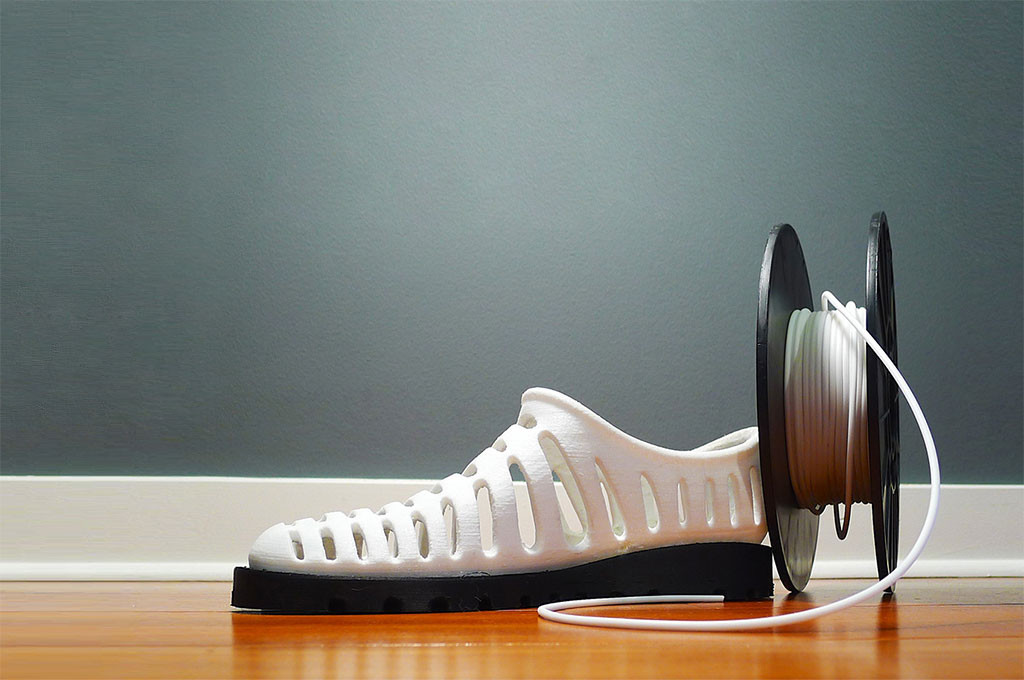Imagine needing a new pair shoes — maybe sneakers to help set a personal record at the next 10K or Crocs for standing around while the kids play soccer. Instead of using Zappos‘ generous shipping and exchange policies, you snap a few pictures of your feet, feed them into an online portal and go pick up new footwear made just for your feet a few hours later at a shop right down the road. That reality isn’t far off. A startup called feetZ is aiming to take the first step and mail custom 3-D printed shoes by the end of the year. That’s only the beginning: Normal Earphones will print headphones from pictures of your ears, Local Motors has developed a running 3-D printed car and GE is creating jet engines using special printing techniques. As the market rapidly expands, it is leaving behind the image of a cottage trinket industry.
Additive manufacturing has existed since the 1980s, but recent advances have downsized the hardware price and footprint. Increased accessibility has driven interest from entrepreneurs and small and large companies alike to a fever pitch. Businesses are beginning to take advantage of the possibilities that rapid, customizable production offers to deliver better products and cut expenses. As printing marches toward new frontiers, commercial real estate professionals can expect the space needs of their clients to change. The just-in-time landscape will shift as consumers demand exact-specification goods, causing changes to inventory, supply chain, density and accounting.
1. Densification
Real estate investors are always looking for ways to add value to their assets, and their clients’ needs are constantly changing. By making smaller parcels available, spaces can fit a wider range of users. As 3-D printing changes what people expect from the buying experience, retailers will be able to take up less room. Office users are already following the same trend. Tenants have learned that high-space layouts aren’t necessary for healthy environments and are downsizing. Many use the money they save to move into higher quality places. With rapid manufacturing, producers and retailers can cut down on awkward, hard-to-manage inventory. They can use fewer modeling tools to predict demand and instead print what people want when they want it — from just a few spools of media.
2. Location
“Location, location, location …” The old adage. Where a retailer chooses to put up shop might not be the only thing that creates success, but it could guarantee failure. 3-D printing is categorized as light manufacturing, which means that it can only happen in industrial areas without a zoning variance. Producers and retailers need to think outside the box when deciding whether to use warehouse and industrial spaces as printing depots, with storefronts for point-of-pickup, or offer printing and sales in the same place. There are no formulas for early adopters to follow, and there will be lots of questions, as getting it right can mean a much more efficient supply chain.
3. Taxation
Everybody knows that the Internet changed retail forever. It took consumer choice to a completely new level and delivered products at amazing prices. 3-D printing will take that market and offer its users limitless potential. Regulators will be salivating when they hear that growth means taxation. The Internet explosion happened so quickly that there was a long period where the government missed out on revenue. That will not happen again. Where printing takes place — at industrial depots or in on-demand storefronts — could influence how taxes are applied. They could even become a regular part of real estate accounting.
The frontier of the possibilities of 3-D printing
3-D printing promises to deliver exactly what consumers want, eliminate some pretty big logistical problems and revolutionize manufacturing. It is already capturing the imagination of innovators, who see complete hardware stores tucked into databases and custom makeup from the comfort of home. Even biomed is improving organ creation, dentistry and pharmaceuticals. The America Invents Act and expansion of the U.S. Patent and Trademark Office ease the process for inventors to protect their ideas, securing a future for creativity.
Moore’s law teaches us that technology tends to advance itself quickly. The Internet changed the way the world does business, and technology is going to shift how we think again. Boundaries are being pushed on a daily basis; every nook and cranny of manufacturing and sales will be touched. Businesses that choose 3-D printing will look for spaces that allow them to work most efficiently. Whether that means smaller leasable areas or specially zoned properties, we should all look out for changing priorities. After all, nobody is printing new buildings … just yet.
Anjee continues to be an insatiable collector of all things retail. She’s a student of culture living next door to future shoppers, whose fleeting trends constantly change the retail landscape … driving retailers, landlords and developers crazy!

 Anjee Solanki
Anjee Solanki

 Lex Perry
Lex Perry
 Colliers Insights Team
Colliers Insights Team